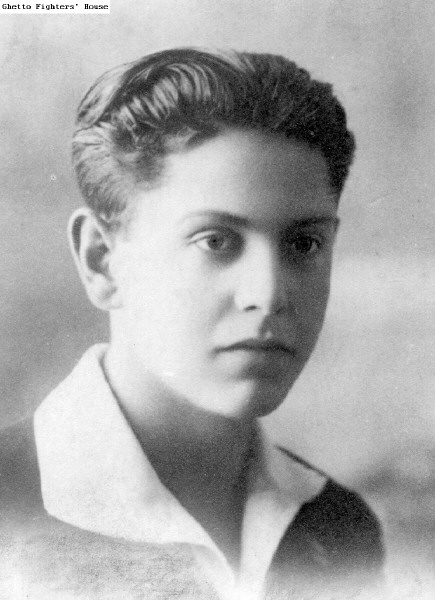Menachem Linder (1911-1942)
Talented scholar and social activist, founder of JIKOR (Jewish Cultural Organization in the Ghetto), collaborator of Oneg Shabbat, murdered on “Bloody Friday” in 1942.
He was born in 1911 in Sniatyn, in eastern Galicia (now Ukraine). He graduated from a Jewish religious primary school, then a Polish state high school. As a teenager, he and his siblings were members of the Zionist and leftist organization HaShomer HaTzair. His brother and sister left for Palestine in the late 1920s. There, his sister Oka’s was one of the founders of the Mishmar HaEmek kibbutz in Israel. Menachem probably would have left for Palestine too, if not for his love of the Yiddish language and culture. He studied at the Jan Kazimierz University in Lviv, where he earned a master’s degree in law. Due to legal restrictions imposed on Jews in practicing law profession, he did not become a lawyer, but undertook further studies. In 1935, Linder won a competition for a monograph on Jewish towns organized by the aid organization CEKABE, which made him recognizable in the academic world. That same year, he became a doctoral student at the YIVO Jewish Research Institute in Vilnius, where he focused on economics. He married Sara, a Vilnius native and graduate of secular Jewish schools. Two years later, they moved to Warsaw, after Menachem was offered the position of secretary of the Warsaw Friends of YIVO Association. He soon became a researcher in the economics and statistics department, under the scientific supervision of economist Jakub Leszczyński. He was also co-editor-in-chief of the journal “Jidisze Ekonomik” (Jewish Economics). In the 1930s, he published research papers by YIVO publishing houses on social economy, demography, and economic relations among the Jewish population in Poland. Among other things, he conducted important research on the role of Jews in the textile industry in Łódź.
Writer Chawa Slucka-Kestin recalls Linder as follows:
“I first met him during my aspirantship in Vilnius. He immediately approached the aspirants and me to get to know us in the second session. It was a winter, cloudy day, but joy and life entered with Linder’s entry. Thanks to his incredible simplicity and friendship he immediately became a comrade on a first-name basis. In the home environment he was called Majni. In the world of pupils and students – Maks, in the YIVO environment Menachem. (…) When I met him on Leszno Street, with his delicate, noble wife, a few days before my departure from Warsaw in October 1939 and proposed a joint trip, he refused, saying that he had to look after the (YIVO) department and wanted to stay because of his social mission.”
In the ghetto, Linder was the head of the registration department of the Jewish Social Self-Help (ŻSS), his office was located at 3/5 Tłomackie Street. As part of his work for the ŻSS, he prepared statistical reports on the ghetto residents, their health, food, employment, as well as on the refugees and displaced persons arriving in the ghetto. As Emanuel Ringelblum wrote: “As a conscious socialist, he harnessed science to work for everyday social assistance.” His research on the increased mortality of the Jewish population, which was the result of the German policy of systematic starvation and destruction of the Jewish nation, was especially interesting. Together with Jerzy Winkler, he worked on economic issues as part of the project “Two and a Half Years of War”, the aim of which was to provide a comprehensive description of the functioning of Jews in German-occupied Poland. He was a regular collaborator of the Oneg Shabbat team documenting the lives of the ghetto residents; some of his work for the ŻSS became part of the Ringelblum Archive.

Menachem Linder | Ghetto Fightters’ House
Politically, Linder moved to the left of HaShomer Hatzair during his university studies after coming to the conclusion that Yiddish was crucial to ensuring the survival of the Jewish nation. His social circle consisted mainly of Bundists and sympathizers of the Poale Left party – meaning the Yiddishists. In December 1940, Linder founded the Commission for the Promotion of Yiddish in Jewish Public Life, and later co-founded the underground cultural society JIKOR. The organization’s goal was to promote Yiddish culture and language and to curb assimilation (Polonization) among the Jewish intelligentsia. JIKOR was very active in organizing lectures on Jewish culture and history, concerts, dance evenings, and theater performances. The literary evenings commemorated important events in the history of Jewish literature, paying tribute to such classics as Mendele Mojcher Sforim and Sholem Aleichem; they also popularized contemporary Yiddish poetry and prose. JIKOR also established a network of Yiddish-language primary schools and a library with Jewish literature. Meetings were organized by House Committees in tenement houses, in ŻSS premises and at the organization’s headquarters at Tłomackie 5 (the building of today’s Jewish Historical Institute). Admission to the events was subject to a fee, and the proceeds were used to help those most in need in the ghetto. The organization also fought to strengthen the position of Yiddish in public life. YIKOR contacted Adam Czerniakow and the Jewish Council demanding that Yiddish become the mandatory language of the Judenrat.
Menachem Linder was the heart and soul, a dedicated promoter of JIKOR. The events organized by the organization enjoyed growing interest. The underground press and cultural life flourished in the ghetto, and for some time it seemed that the Germans were not interested in the political and cultural activities of the Jews. The night of April 17-18, during which Linder died, destroyed this illusion. The Germans murdered 52 people: social activists, owners of print houses, representatives of the intelligentsia and people of the underground. These events were called “Bloody Friday“. This first collective action of terror was a prelude to the Great Liquidation Action of the Warsaw Ghetto, which took place three months later, in July 1942.
Ringelblum wrote:
“Gestapo agents went from house to house in the evening with a list in their hands, pulled out their victims and shot them one by one. At about half past eleven at night they came to Linder, asked him about his research, behaved politely and gentlemanly, finally took him with them to their car and drove him to Mylna Street. There were already other Gestapo agents there, who ordered Linder to go ahead, they lit light onto him and stuck a bullet in his head. (…) His hot young blood washed away the cold cobblestones.”
After Linder’s death, his terrified wife burned his diary, which he had kept for many years.
Ringelblum recalls that several hundred of Linder’s friends gathered in the courtyard of the tenement house at 52 Leszno Street to pay tribute to the young Menachem. Several dozen people then managed to escape from the ghetto and go to the Jewish cemetery to bury the young scientist. Menachem Linder’s grave is located in the Jewish cemetery in Warsaw.
Bibliography:
- AZIH, Slucka-Kestin Relation, 301-2581
- Rachela Auerbach, Warsaw Testament, Dalton MA 2024
- Icchak Cukierman, Nadmiar Pamięci, Warsaw 2023
- Ringelblum Archive, volume 11 “Oneg Szabat”, Warsaw 2013
- Ringelblum Archive, volume 1 “Letters about the Holocaust”, Warsaw 1997
- Ringelblum Archive, volume 29, “Pisma Emanuela Ringelbluma”, 2020
- Miszmar Haemek: https://tiny.pl/6x2bt06c
- Lexicon Fun Der Nayer Yidisher Literatur: https://congressforjewishculture.org/people/3416/Linder-Menakhem-Menachem-July-8-1911-April-18-1942

